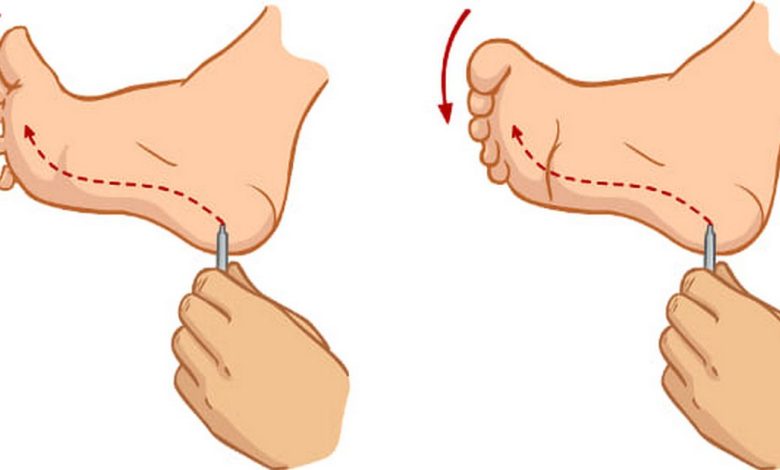Babinski's reflex: what is this, causes, symptoms, diagnostics, treatment, prevention

Babinski reflex; Reflex – Babinski; Extensor plantar reflex; Babinski sign
Babinski's reflex, or Babinski's syndrome, is a medical condition, which manifests itself in the form of an unexpected and uncontrolled contraction of the muscles of the leg. This reflex can occur at any time and can be very painful..
Manifested in the extension of the first toe with a dashed irritation of the skin of the outer edge of the sole.
Causes of the Babinski reflex
The presence of the Babinski reflex in a child older 2 years or in an adult is often a sign of damage to the central nervous system. The central nervous system includes the brain and spinal cord. Violations may include:
- Amyotrophic lateral sclerosis (Lou Gehrig's disease)
- Tumor or brain injury
- Meningitis (membrane infection, covering the brain and spinal cord)
- Multiple sclerosis
- Trauma, defect or tumor of the spinal cord
- Stroke
- Neurodegenerative diseases
Babinski reflex symptoms
The symptoms of the Babinski reflex are sudden and uncontrollable muscle contractions in the leg., which can cause pain and discomfort. This reflex can also cause unsteadiness and falling..
Diagnosis of the Babinski reflex
Diagnosis of the Babinski reflex includes an examination of the patient and several diagnostic tests, such as electromyography and neurological examination. Radiation diagnostics, such as CT or MRI, can also be used to find the cause of the reflex.
The doctor runs the handle of the malleus along the lateral edge of the foot. Implementation should be easy, non-painful. With a positive symptom of Babinsky, in response to irritation, a fan-shaped extension of the toes occurs.. Normal plantar reflex, manifested by involuntary flexion of the thumb, or no response.
Babinski reflex treatment
Treatment for the Babinski reflex depends on the cause and may include physical therapy, medical treatment or neurosurgical intervention.
Treatment of the Babinski reflex at home
Babinski reflex home treatment may include some simple ways, such as strengthening muscles and maintaining proper posture, to reduce the risk of falling.
Prevention of the Babinski reflex
Babinski reflex prevention involves seeing a doctor to treat related conditions, such as infection or neurological disease, and maintain a healthy lifestyle, including regular physical activity, a diet with enough vitamins and minerals, as well as correct posture.
It is important to remember, that the Babinski reflex is a serious condition, which requires immediate treatment. People, suffering from this reflex, falls should be avoided and see a doctor for diagnosis and treatment. Proper treatment and prevention can help reduce the risk of recurrence and improve quality of life for people, suffering from the Babinski reflex.
Used sources and literature
Deluca GC, Griggs RC. Approach to the patient with neurologic disease. In: Goldman L, Schafer AI, eds. Goldman-Cecil Medicine. 26th ed. Philadelphia, PA: Elsevier; 2020:chap 368.
Mostoufi SA. Cervical radiculopathy. In: Frontera, WR, Silver JK, Rizzo TD Jr, eds. Essentials of Physical Medicine and Rehabilitation. 4th ed. Philadelphia, PA: Elsevier; 2019:chap 5.
Schor NF. Neurologic evaluation. In: Kliegman RM, St. Geme JW, Bloom NJ, Shah SS, Tasker RC, Wilson KM, eds. Nelson Textbook of Pediatrics. 21st ed. Philadelphia, PA: Elsevier; 2020:chap 608.
